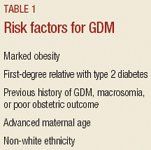How, when, and why to test for gestational diabetes mellitus
Whether to test for GDM is a common quandary in ob/gyn practice. This article will help you make evidence-based decisions about which patients to test and which assay to use.
Gestational diabetes mellitus (GDM) is common and complicates approximately 4% of all pregnancies in the United States.1 It is defined as carbohydrate intolerance of variable severity that begins or is first recognized during the index pregnancy.2 This definition applies even if the woman is not treated with insulin and her condition persists after pregnancy. Although GDM typically develops during the second half of pregnancy, the glucose intolerance may actually have preceded conception.2

Our current criteria for screening and diagnosing GDM are based on the landmark epidemiologic studies of O'Sullivan and colleagues.4,5 Originally designed to identify a subset of pregnant women at increased risk for developing type 2 diabetes later in life, their criteria were validated by the ability to predict that 22.6% of women would develop glucose intolerance when not pregnant after 8 years and 60% after 16 years. In the past, clinical and historical risk factors were used as indicators for oral glucose tolerance testing (OGTT) in pregnancy. But factors such as giving birth to a previous macrosomic infant, family history of diabetes, obesity, excessive weight gain during pregnancy, glycosuria, proteinuria, and hypertension have been found to capture only about 50% of cases of GDM.6 Therefore, since the 1980s, the 50-g glucose challenge has been routinely used in North America to identify women who warrant diagnostic testing for GDM.
In the US, screening for GDM consists of a 50-g oral glucose load, followed an hour later by plasma glucose determination. The test is performed without regard to the time of day or interval since the last meal. Screening is recommended between 24 and 28 weeks' gestation in women not known to have diabetes mellitus. This approach is endorsed by the American College of Obstetricians and Gynecologists, the Expert Committee on the Diagnosis and Classification of Diabetes Mellitus, the North American Diabetes in Pregnancy Study Group (NADPSG), and the Fourth International Workshop Conference on Gestational Diabetes Mellitus.2
In 1966, the 4th International Workshop Conference recommended that a risk assessment for GDM be conducted at the first prenatal visit. Furthermore, they recommended screening women who were considered to be at high risk for GDM as soon as possible, while those at average risk could be tested at between 24 and 28 weeks' gestation.
Study links COVID-19 infection to higher low birthweight and preterm birth rates
March 24th 2025A new study found that pregnant women infected with COVID-19, especially in the third trimester or with severe symptoms, faced higher risks of preterm birth, low birthweight, and neonatal intensive care unit admission.
Read More
Expression of mRNA linked to fetal death risk
March 18th 2025A recent study reveals significantly elevated placental interleukin 6 and vascular endothelial growth factor receptor 2 messenger RNA expression in fetal death cases, highlighting inflammation and impaired fetal protection mechanisms.
Read More



















